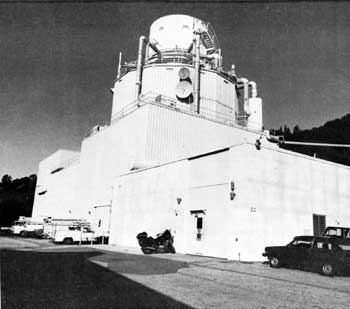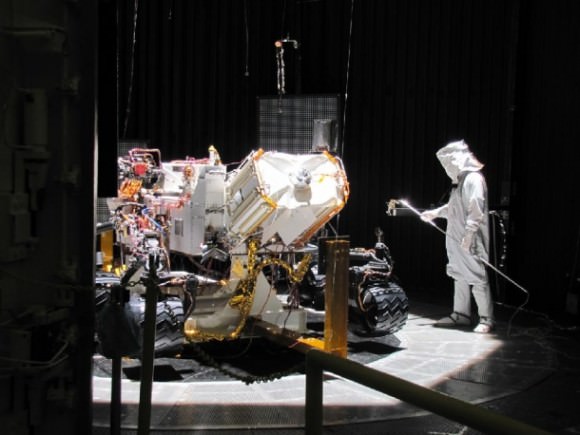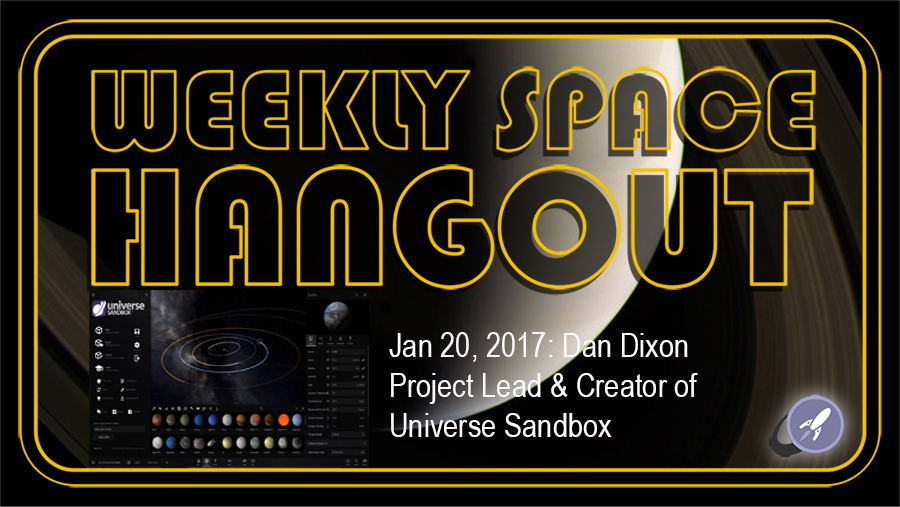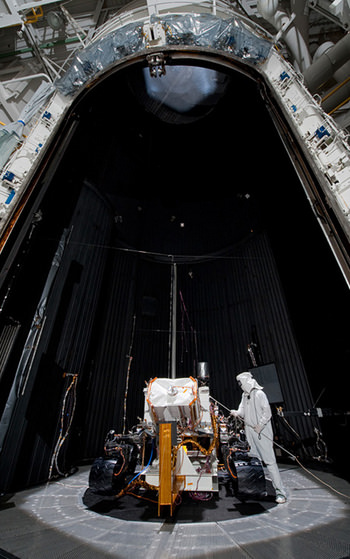The Mars Science Laboratory rover, Curiosity being tested under Martian conditions in JPL’s space simulator on March 8, 2011. Credit: NASA/JPL-Caltech
This is a place where engineers inflict all sorts of cruelty. It’s also a National Historic Landmark that is now 50 years old. What is it? The Jet Propulsion Laboratory’s Space Simulator. While the name sounds like it could be a video game or virtual reality trainer, it actually is the place where spacecraft go to see if they’ve the right stuff to survive the harsh environment in space.
Known as the “25-Foot Space Simulator,” it is capable of producing true interplanetary conditions such as extreme cold, high vacuum, and intense solar radiation that is big enough for most spacecraft to fit inside.

Exterior View of Twenty-Five-Foot Space Simulator, in 1983. Credit: NASA/JPL.
Just like the feared simulations that astronauts go through during training for a spaceflight, where Sim-Sups (Simulation Supervisors) conjure up all sorts of scenarios where everything that can go wrong does, the Space Simulator allows engineers to test the complete spacecraft in its flight configuration for most any type of conditions, searching for any problems imaginable.
Over the years spacecraft tested in this facility include the Ranger, Surveyor, Mariner, and Voyager spacecraft and recently, the Curiosity rover took its turn inside this torture chamber.
Doug Smith from Caltech’s Engineering & Science magazine calls it the Ultimate Evil Tanning Bed — expressly designed to deliver a fatal sunburn to anything placed inside.
The Space Simulator chamber is a stainless-steel cylindrical vessel 8.23 meters (27 feet) in diameter and 26 meters (85 feet) high. The walls and floor are lined with thermally opaque aluminum cryogenic shrouds that can deliver a temperature range of -195° to 93° C ( -320° to +200°F) by liquid or gaseous nitrogen. The solar simulation system consists of an array of 37 xenon 20- to 30-kilowatt compact arc lamps that can produce a variety of beam sizes and intensities. If your spacecraft is going to be seared by the Sun at Mercury or be subject to the freezing temperatures in the Kuiper Belt, this facility can test if every bolt, wire, switch, solder point and component can survive.
Once a spacecraft is put inside the chamber, it takes about 75 minutes to get the conditions to the desired levels, and depending on how quickly the engineers want to see how their spacecraft fared, test conditions can be terminated and access provided to the test item in about 2-1/2 hours.
There’s even a setting for geosynchronous orbit simulation that can test declination angle change and much more, all in a vacuum environment.
The facility’s construction started in 1961 and was completed in 1962 at a cost of $4 million.
The first spacecraft to submit to the torture chamber’s extremes was the Mariner 1 spacecraft that was headed to Venus. It passed the torture chamber’s test, but unfortunately the spacecraft had to be destroyed by a Range Safety officer within minutes after it veered off-course during launch on July 22, 1962 due to a defective signal from the Atlas launch vehicle and a bug in the program equations of the ground-based guiding computer. (The Space Simulator just can’t test for problems like that, regrettably.)
But, JPL had already built an identical spacecraft and Mariner 2 launched a month later on August 27, 1962, sending it on a 3½-month flight to Venus.
In the 50 years the Space Simulator has been in operation, every spacecraft built at JPL has been subject to the torture chamber before heading out to the real torture of the harsh space environment.
“It’s a rare thing when a spacecraft goes into the simulator and the engineers don’t learn something important and modify the design to work better,” saids Andrew Rose, the technical manager for JPL’s Environmental Test Laboratory group.

The Curiosity rover inside the Space Simulator. Credit: NASA/JPL
Over the years, the simulator has been upgraded to provide all sorts of environments, and earlier this year, the Curiosity rover took its turn inside, being sealed in a near-vacuum environment, with temperature cooled to – 130° C (-202 ° F) with the giant light panels simulating the sparse Mars’ sunshine and the various radiation intensities found on Mars.
Even more evils await future spacecraft that will be tested in JPL’s Space Simulator.
This article was updated on 9/8/2012
Sources: Caltech, National Park Service




